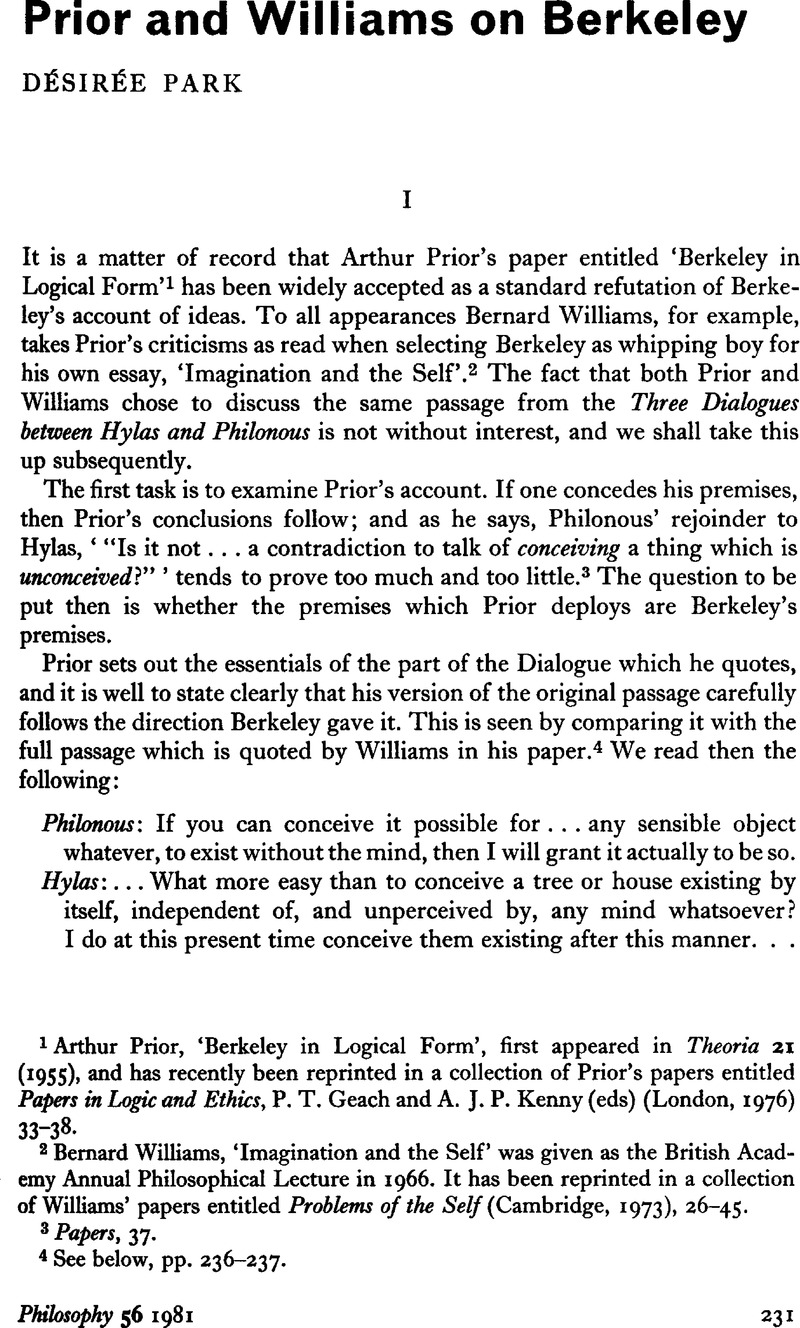Article contents
Prior and Williams on Berkeley
Published online by Cambridge University Press: 30 January 2009
Abstract

- Type
- Discussion
- Information
- Copyright
- Copyright © The Royal Institute of Philosophy 1981
References
1 Prior, Arthur, ‘Berkeley in Logical Form’, first appeared in Theoria 21 (1955)Google Scholar, and has recently been reprinted in a collection of Prior's papers entitled Papers in Logic and Ethics, Geach, P. T. and Kenny, A. J. P. (eds) (London, 1976) 33–38.Google Scholar
2 Bernard Williams, ‘Imagination and the Self’ was given as the British Academy Annual Philosophical Lecture in 1966. It has been reprinted in a collection of Williams' papers entitled Problems of the Self (Cambridge, 1973), 26–45.
3 Papers, 37.
4 See below, pp. 236–237.
5 Papers, 37. Prior's symbolism has been omitted for the sake of brevity; but in each case discussed, his own rendering of the symbolized expression has been quoted. In the Luce and Jessop edition of Berkeley's Works (Edinburgh, 1948–57), this passage is in Vol. II, T. E. Jessop (ed.) 200.
6 Ibid.
7 Somewhat earlier in the Dialogue, Berkeley had stated: ‘… thus much seems manifest, that sensible things are only to be perceived by sense, or represented by the imagination’ (Works, Vol. II, 194).
8 On Berkeleyan ideas and their essential limitations, see my Complementary Notions: A Critical Study of Berkeley's Theory of Concepts (The Hague, 1972). This account, which is based on all of the written evidence about Berkeley's treatment of ‘ideas’ and ‘notions’, including the MS notebooks, the sections of the Principles MS, the Chapman MS and the surviving letters, traces the function of notions as a counterpoise of ideas from the earliest period of the notebooks down to the last revision of the Siris. See especially Chp. I, pp. 15–35; II, pp. 36–53.
9 Works, Vol. II, 79–80.
10 On imaging, remembering and Berkeleyan concepts, cf. Complementary Notions, 37–39 and 100ff.
11 Papers, 38.
12 Ibid.
13 Ibid.
14 Berkeley made use of his characters for bringing criticisms with which he agreed, as well as for dramatic effect. Notice the role of Hylas in the Third Dialogue, Works, Vol. II, 234–235, and that of Alciphron in opposing the pious Euphranor in Alciphron: or The Minute Philosopher, Vol. III. See also Complementary Notions, 17–19.
15 ‘… an idea can be like nothing but an idea; …’ Works, Vol. II, 44. For the notebook MS entries, see Add. MS 39305, fol 55r and 94r, given in Complementary Notions, 130 and 51. See also discussion in Chp. VI, section on ‘Object and Likeness’, 129–137.
16 For this reason Berkeleyan ideas have never quite marched with any of the various sense-data theories. Cf. Complementary Notions vs. Russell, 47–48 and 108–111.
17 On this consequence, see my Persons: Theories and Perceptions (The Hague, 1973), 11–13 and 68–69.
18 Works, Vol. II, 41–42.
19 See discussion below, section III.
20 Problems, 26.
21 See above, p. 232, n. 7.
22 Works, Vol. II, 198–199.
23 Ibid., 201f.
24 Problems, 27.
25 For an account of the several kinds of ‘ideas’ and ‘notions’ and Berkeley's use of ‘perceive’ and ‘conceive’, see Complementary Notions, 36–43, 54–57, 62–64 100–105, and for the MS notebooks pp. 25–35.
26 Works, Vol. IV, A. A. Luce (ed.), who puts the date in the autumn or winter of 1707, p. 234.
27 Ibid., 235–238
28 Problems, 27.
29 Ibid.
30 Problems, 27.
31 Works, Vol. II, 55.
- 1
- Cited by


